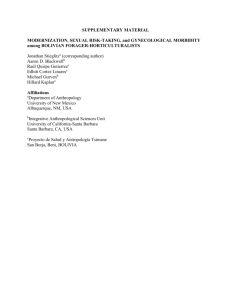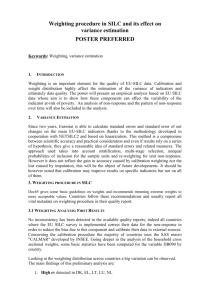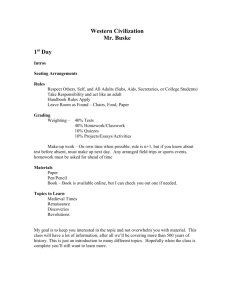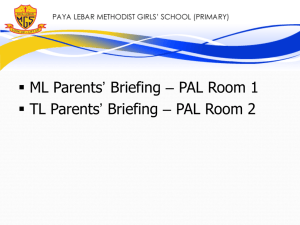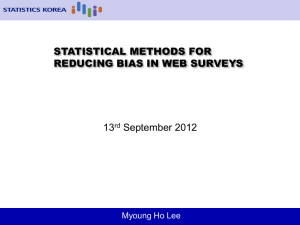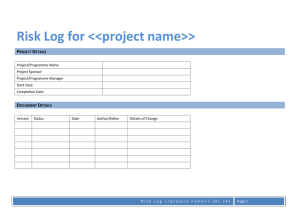The Scottish Government
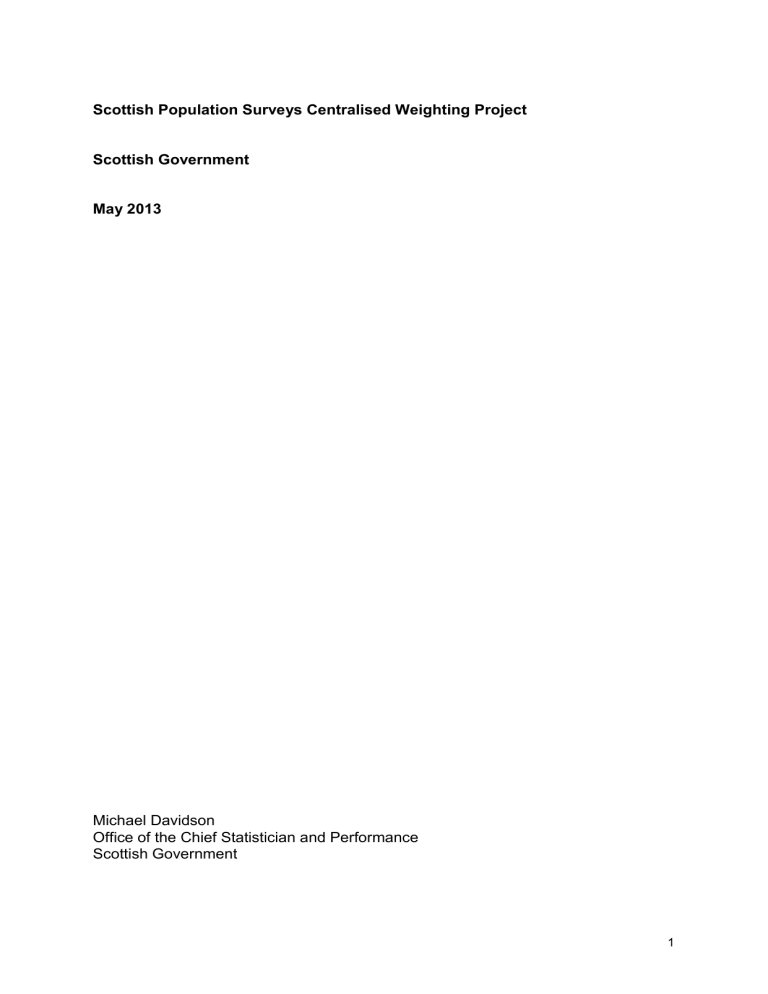
Scottish Population Surveys Centralised Weighting Project
Scottish Government
May 2013
Michael Davidson
Office of the Chief Statistician and Performance
Scottish Government
1
1. Introduction
1.1 Introduction
This paper presents a review of the Scottish Government’s Centralised Weighting
Project. The Scottish Government conducted three 1 large scale population surveys; the Scottish Household Survey (SHS); the Scottish Health Survey (SHeS); and the
Scottish Crime and Justice Survey (SCJS). The SHS and SHeS are run every year and follow the calendar year, while the SCJS is biennial and follows the financial year.
Previously the survey weighting was undertaken independently for each of the surveys by the survey contractors. However, in order to deliver a pooled sample and as part of the wider harmonisation work, the weighting of raw survey data from 2012 onwards is being undertaken by the Scottish Government. Prior to the project the
Scottish Government had an understanding of the weighting methodologies applied to previous surveys. However, we did not have proven technical experience of designing and implementing a multiple survey weighting methodology. The project aim was to establish that expertise within Scottish Government.
The project was delivered by Office of the Chief Statistician and Performance and
ONS’s Methodology Advisory Service (MAS), with the resources for the MAS input supplied through the Quality Improvement Fund.
1.2 Project Requirements
One of the most important functions of the surveys is to measure change in specific measures across a range of topics. In developing the weighting project, one of the principal concerns raised by users was the time series comparability of survey data.
To address this, it was decided that for each of the surveys the weighting methodology developed and implemented by the Scottish Government should replicate that used by the individual contractors. An outline of the weighting methodologies for each of the surveys’ weights are provided in section 3 of this paper.
A more detailed review of the methodologies is a longer term ambition for the
Scottish Government. While it might have been desirable to conduct a full scale review of the weighting methodologies in this project, due to the timescale and resources available this was not feasible. Also, since the weighting methodologies have been functioning successfully for the individual contractors there is no great need to modify them and any revision of the methodologies might lead to a requirement to re-weight previous datasets. Finally, there would have been a risk associated with changing the weighting methodology and technology simultaneously as it might not be possible to separate out the impact of each.
1 Prior to 2012 the Scottish Government also ran the Scottish House Condition Survey (SHCS) but from the beginning of 2012 the SHCS became a module of the SHS.
2
From the beginning of 2012 all three surveys included a core of 20 harmonised questions. The data from these questions will be pooled to provide a larger dataset.
The successful development of the pooled sample will:
Provide increased precision of estimates for these variables at a national level
Provide more accurate estimates of the numbers of people in small population groups such as specific ethnic groups or religions.
Significantly increase the precision of estimates at Local Authority level.
Allow for sub-Local Authority estimates to be reported, which is currently only available from the census every 10 years, so survey data will be increasingly important as we move further away from 2011.
The first year of dissemination of the pooled data will provide a snapshot of the
Scottish population. With subsequent publications it will be possible to develop time series to examine the change in variables. As this is a new dataset, a weighting methodology for the pooled sample required development.
Since the weighting methodologies for the individual surveys are not being revised, the primary aims of the project were:
Gain an in-depth understanding of the weighting methodologies implemented for the individual surveys
Develop a weighting methodology for the pooled sample
Develop code for statistical software which can implement the specified methodologies.
Previously each of the survey contractors used different software systems to perform the survey weighting. The details of the software used is specified in Section 2. For the project it was the intention of the Scottish Government to implement the weighting methodologies using a single platform.
1.3 Rationale and Technical Background for Survey Weighting
Data gathered through the Scottish population surveys is broadly representative of the characteristics and views of the population. However, due to variations in response rates between different groups and sample design, certain groups might be underrepresented in the samples. The Census provides the best available demographic data on the Scottish population. While the Census is only run every 10 years, the National Records of Scotland (NRS) provides annual estimates on key characteristics of the population.
For example, for the 2010 Scottish Household Survey random adult dataset, analysis of the raw survey data finds that 8.4% of respondents were in the 16-24 age group.
However, from NRS 2010 mid-year estimates 14.5% of the 16+ population was in the 16-24 age group. To counteract the under representation of 16-24 year olds in the sample, the survey responses for 16 to 24 years olds require ‘weighting up’.
3
To provide analysis that more accurately represents the population, the raw survey data require weighting so that the composition of survey responses matches the composition of the population as a whole across key variables. The weighting process derives a survey weight value for each record in the survey dataset to match survey data for a number of variables (e.g. the SHS uses age/sex profile) with population estimates. When analysis of the dataset is carried out each record is multiplied by its respective weight to give survey findings which are representative of the population as a whole.
In more technical terms, weightings are applied to the analysis of survey responses for two main reasons:
Firstly, to account for deliberate unequal probabilities of selection for individuals, households or other units from the population. These are referred to as design or selection weights.
Secondly, they are applied to counteract the impact of unequal response rates within the population, referred to as non-response weights.
For non-response weights, two different methods are applied for the Scottish
Government surveys:
Sample-based non-response weights which use information contained in the sample responses to estimate probability of response for different subgroups.
This is applied in the SHeS using logistic regression.
Population based weighting (also referred to as calibration weighting) where totals for survey data are matched to known totals for the population. This is applied in all three surveys.
1.4 Acknowledgements
We are grateful to Charles Lound and Peter Broad from the Methodology Advisory
Service for their work and support on this project. We would also like to acknowledge the help given by Ipsos-MORI, TNS-BMRB and ScotCen through providing comprehensive information on the weighting methodologies and computer code implemented for previous surveys.
4
2. Technical requirements
2.1 Introduction
Previously different computer software was used to implement the weighting methodologies for each of the surveys by the responsible contractors. Since the
Scottish Government intended to use the same platform to weight all survey data, consideration of the different options was required.
2.2 Software Selection
The table shows that three of the surveys used bespoke solutions to implement the weighting, while the g-Calib add-in for SPSS was used for the SHS.
Table 2.1 –Weighting Software Implemented
Survey Software implemented
SCJS
SHeS
Bespoke calibration macro in MS Excel
Bespoke calibration macro in Stata
SHS
SHCS
SPSS and g-Calib add-in
Bespoke calibration macro in SPSS
In considering the options there was the desire that any solution should be flexible such that the methodologies could be reviewed in the future. Also, compatibility with the Scottish Government’s existing statistical software package (SAS) would be advantageous.
The following table presents a selection of some of the packages available for weighting and comments on each one.
Table 2.2 – Calibration Weighting Software Options
Base software
Module/macro name
Methods Comments
SAS
SPSS
Calmar-2 g-Calib
Different formulations for population based weighting
Different formulations for population based weighting
Documentation and code comments in
French and might require the SAS/IML and
SAS/STAT packages
Unclear if it functions with the latest SPSS releases
R ReGenesees Different formulations for population based weighting
Both the base software and package are free to download and use
Can call on R procedures from SAS but need SAS/IML package, however, can transfer data from SAS to R and back negating IML requirement.
Expensive initial purchase and ongoing site SAS GES Different formulations for population based weighting licences
SAS has been suggested as the main syntax for the weighting syntax as this software is used by a wide number of statisticians, not only in the GSS, but across
5
other statistical institutions. Although the licence for SAS can be quite costly, SAS is already used by the Scottish Government for the survey sampling.
R is free and is growing in popularity among statisticians and researchers. The syntax is quite different from SAS, but it was possible to arrange the coding framework so that only a basic understanding of R would be sufficient. The calibration step is run completely separate from SAS, where SAS creates R code and then calls on R to run this. This avoids the potential complexity of SAS IML
(Interactive matrix programming).
As a result of these benefits, the combination of SAS and R was adopted for the implementation of the weighting methodologies. The actual R package used for the calibration is ReGenesees , which was developed by Diego Zardetto from the
National Institute for Statistics in Italy (Istat). It builds on existing R package survey , but adds extra functionality. There is potential for this package to do a lot more than included here. This particular package requires R version 2.10.0 or higher and also uses the R package MASS .
While R software is free to download, there was a delay in it being available on the
Scottish Government systems due to it needing to be validated for use by IT support.
This led to delays in the completion of the project.
6
3. Development of code
3.1 Introduction
This section presents an outline of the development of the weighting syntax followed by a summary of the steps required for each of the surveys. The summary provides information for the survey s’ multiple units for analysis as each of these units has a slightly different weighting methodology. At the commencement of the project the
Scottish Government undertook a more detailed review of weighting methodologies.
The paper is attached below.
Scottish Population
Surveys - Review of Weigthing Procedures.doc
3.2 General Development
Overall, the weighting structure, common to all surveys, includes the following broad six steps:
A. Collate and prepare input data for weighting
B. Calculate design weights
C. Calculate sample-based weights
D. Calculate calibration weights
E. Manipulate final weights
F. Collate output weights for delivery
Not all weights use each step and some survey weights use the same step multiple times as each survey has its own requirements. Within each step there are also some quality assurance (QA) checks so the processes can be validated.
All weights require similar steps but have different inputs, so macros are implemented. This is not only good practice to save memory and line space within the program due to the number of repeat calls, but macros are also more robust. Any changes to the way the macro runs will be due to the input parameters and the options these define. Some steps, however, are quite different and each survey requires a slightly different approach.
All steps are implemented in SAS, but steps C and D include a macro call to another
SAS file. In step C, this calls a logistic regression used to model the probability of non-response and in step D this calls a SAS program which itself creates an R program to carry out the calibration weighting in R.
3.2.1 Step A – Data Preparation
The first step depends on the individual survey as there may be multiple data sources that need to be merged and variables may need deriving for weighting. This is carried out in SAS using a mixture of data steps and proc import, proc sql and proc transpose steps.
7
3.2.2 Step B
– Design Weights
This step calculates the design weights to adjust for over-sampling by stratum and for sampling within households (if only one adult is selected). For example some areas may be oversampled due to boosts to the sample, such as the health board boost in the SHeS, or in other surveys only one adult may be sampled per household where more than one adult may live there.
Adjusting the data according to the number that were sampled and the number in the population rectifies oversampling by stratum and using the number of adults in the household accounts for sampling only one person per household.
The SAS code includes a QA check to ensure the design weights sum to the correct totals as appropriate.
3.3.2 Step C – Sample Based Weights
SHeS is the only survey which currently uses sample-based weighting to account for non-response, but a macro has been implemented because the SHeS uses this step for four of the seven weights. The response weight could be derived by using the reciprocal of the response rate in each of the weighting classes, but in SHeS a logistic regression model is used.
A number of variables are considered for the model, but those included in the final model will change each year depending on the data. Therefore the code is not fully automated as it requires the user to evaluate the model and decide which variables to include or exclude. However, there are options which help to identify the potential variables. These are known as forward and backward selection. For each approach the program assumes certain variables must be included in the model and then adds or removes extra variables depending on the performance of the model for forward and backward selection respectively.
Forward selection starts with selected variables and adds one of the remaining variables depending on a chi-square statistic. If it is significant to a level defined by the user, the variable will be added to the model. Once an effect is entered it cannot be removed. This process repeats until no remaining effects meet the significance level.
Backward selection starts with all variables. It then removes the least significant variable which does not meet the level defined by the user. This process is repeated until no more variables can be removed. As with forward selection, once a variable is removed it cannot be added back in.
The user is required to analyse the results to make sure the variables chosen seem sensible and use this final model to estimate the probability of response. For example, are some estimates for some effects particularly large or is the difference in
AIC significantly different from the default model to warrant these extra variables?
Once these checks have been carried out, the sample-based weight is then simply the reciprocal of this probability.
8
3.3.3 Step D
– Calibration Weighting
To incorporate R in the general weighting framework the code makes a call to a separate SAS program which creates and calls an R program to carry out the weighting 2 . The call to R also produces a histogram of the output weights as well as a scatter of the input weights against the output weights. This requires the lattice R package. These checks can be used for quality assuring the output weights.
The majority of the inputs in the SAS file are carried forward to the R function to carry out the calibration, but some are used within SAS for QA checks. The code also includes a line to scale the weights so the weights sum to the sample size. The R package foreign is needed to export the data from R back into SAS. If there are any problems with the call to R, the ROUT file gives details of any problems.
The calibration in R requires population total files to be in a specific format depending on the calibration model specified. For example the calibration for the individual
SCJS weights is based on age group and sex totals in each Police Force Area (PFA) and Community Justice Authority Area (CJAA). So in the code the age group and sex and the PFA and CJAA variables have been combined for the model and labelled as model = ~pfa_cjaa:age_sex , i.e. the interaction between PFA and CJAA by age group and sex. This requires the population total file to be in the following format:
Table 3.1: Example of Population total file name pfa_cjaaPFA Central Scotland CJAA Fife & Forth Valley:age_sexage16-24:sexFemale
.... total
17250
.... pfa_cjaaPFA Tayside CJAA Tayside:age_sexage80+:sexMale 7450
The code includes an option which creates a population template file based on the input data and the calibration variables defined in a model step. This file is then exported from R as a CSV file ready to be populated with target totals.
The general format is a concatenation of the variable name and the variable value with no spaces in between. If the model includes an interaction term then the concatenation of the variable name and the variable value are separated with a colon. The header titles of the table must be “name” and “total” as these are used in the R code.
2 Due to the way that SAS is set up in the Scottish Government it is not possible to call R procedures directly from SAS code so the syntax has to be split to export data and code to run in R, before running the R code from R and then importing the data back into the SAS environment.
9
3.3.4 Step E – Manipulate final weights
This step is used to manipulate the final weights either through the use of trimming extreme weights or to adjust the household weights for the SHS such that they sum to the number of dwellings in each local authority rather than the number of individuals.
3.3.5 Step F – Collate output weights for delivery
This step is fairly straightforward; it is used to collate the final weights along with the unique identifier and variables used in the weighting procedure. It then outputs these as a CSV file with a simple univariate distribution analysis of the weights in an Excel workbook.
3.4 Individual requirements for each survey
As each survey creates more than one weight and that weight might have different input data, the steps outlined above may or may not be needed for each of the weights or might be required multiple times. The following tables shows the structure of each of the surveys and the different weights required.
Table 3.2: Summary of required survey weights
Survey Weight
Household weight
Individual weight
Individual self-completion weight
Incident count adjustment
Description of unit of analysis
All responding households
Random adult selected within each household
Same random adult, self comp used for sensitive questions, some respondent fatigue
Measurement of crime from victim forms
Household weight
Individual weight
School child weight
Adult interview weight
Adult biological module weight
Adult blood weight
Adult version A weight
Child version A weight
Child weight
Social survey weight
All responding households
Random adult selected within each household
All responding adults (including health board boosts)
Around a third of the sample is pre-selected for the biological module
Adults selected for the biological module are asked to provide a blood sample
Adults in the main sample (excluding health board boosts) that are not selected for the biological module
Children interviewed as part of the main sample
All children interviewed (main sample and child boost)
Households completing the social survey
Physical survey weight Household participating in the follow up physical survey
Table 3.3 below summarises the steps currently needed for each of the weights and each of the surveys. In the future it might be necessary to include other steps, such as the non-response weighting in step C. Step F has not been included in the table as all listed weights will be output.
10
Table 3.3: Summary of weighting steps required for all surveys
Survey Weight
A
Household weight
Individual weight
Individual (self-completion) weight
Incident count adjustment
Household weight
Yes
-
Yes
Yes
Yes
Individual weight
School Child weight
Adult Interview weight
Yes
Yes
Yes
Adult biological module weight
Adult blood weight
Adult Version A (VeraA) weight
Child Version A (VerA) weight
Child interview weight
Social survey weight
Yes
Yes
Yes
Yes
Yes
Yes
B
Yes
-
Yes
Yes
Yes
Yes
Yes
Yes
Yes
-
Yes
Yes
Yes
Yes
Step
C
-
-
-
-
-
-
-
Yes
Yes
Yes
-
-
-
-
D
Yes
Yes
Yes
Yes
Yes
Yes
Yes
Yes
Yes
-
Yes
Yes
Yes
Yes
E
-
-
-
-
-
-
Yes
Yes
-
-
-
-
-
-
Physical survey weight Yes Yes - Yes -
The following section presents the findings from testing the weighting methodologies.
11
4. Replication of Weights
4.1 Introduction
In order to test and verify the weighting syntax for all of the weights specified in table
3.2, the code was implemented using 2009, 2010 or a biennial data set of 2009 and
2010 survey data.
4.2 Replicated Weights
The following charts presents scatter plots for the replicated weights against the weights derived by the survey contractors for one of the weights for each of the surveys.
As the aim was to replicate the weights exactly the objective was for all points to be matched precisely. The charts show there are some residual differences between the replicated and original weights. It was concluded that these resulted from slight differences in variable coding and missing values rather then there being substantive issues. Where there were differences the replicated weights were tested further with key survey variables to ensure they gave the same results as the original weights.
SCJS Household Weight 2009-10 Replication
12
SHS Household Weight 2009-10 Replication
SHeS Adult Weight 2010 Replication
13
SHCS Physical Survey Weight 2010 Replication
14
5. Pooled Sample
5.1 Introduction
As stated in section 1, in addition to deriving weights for each of the surveys, the
Scottish Government also intends to derive weights for a pooled sample from the three surveys. In addition to working within the framework shown in Section 3, the weighting of the pooled sample requires a step to scale and combine the data from the different surveys.
5.2 Pooling Options
There are two basic approaches to producing single estimates from the three surveys:
Combine the data using the weights derived for the individual surveys
Create weights from scratch for the raw pooled data
The first option is more straightforward. Assuming each survey produces an unbiased estimate, the optimum is to combine the survey estimates using a factor inversely proportionate to the variance. This is the same as option D in Kish i (1999) but is there described in terms of (effective) sample sizes. By multiplying the survey weights by this factor, the same combined estimates can be derived directly from the pooled microdata. This combining approach should work equally well for household and individual analyses, even though the procedures for sampling individuals within households are quite different.
The alternative approach is to pool the data first and then build up the new pooled weights from scratch. This would be complex as decisions would have to be taken at each step of the process: design weighting; non-response weighting and calibration.
For example, a decision would be needed on how to deal with the fact that in some cases only one adult is sampled and in others all are sampled.
A stronger objection to the alternative approach is that the data are collected from three quite distinct surveys, with different data collection agencies each with their own policies and practices that may influence the profile of responders. This would suggest that rather than pooling the data and applying the same weighting process across the board, it is better to apply the separate weighting methodologies that should be specific to the outcome of that survey.
The ONS Integrated Household Survey uses a mixture of the above, pooling the single-stage surveys and keeping the multi-stage surveys separate. These components are individually calibrated to population totals before being combined using a factor in similar form to that described above, applied regionally. The final, combined dataset is then calibrated to population totals. Calibrating the combined dataset in this way offers the opportunity to incorporate more detailed weighting classes than could be applied to the separate surveys.
15
5.3 Next Steps
Due to the significant changes in the sample design for the surveys (both SHS and
SCJS use unclustered rather than clustered samples from 2012 onwards) it was considered that there would be no value in generating weights for survey data from previous years.
Instead the weighting methodology will be developed once 2012 survey data has been received from contractors and the individual surveys have been weighted. The weighting methodology will be developed within the framework presented in section 3 with the following issues requiring consideration:
Calibration weighting to more detailed weighting classes (e.g. sub-local authority populations)
Scaling factor for combining the data from the different surveys
The development of the pooled dataset will require detailed quality assurance involving analysts from across the topic areas covered by the core questions.
16
6. Conclusions
This project has been hugely beneficial to the Scottish Government in giving us the skills and capacity to undertake complex weighting for survey data. While the basis of the project was for us to replicate the methodology which had previously been implemented for the surveys and have a weighting framework in place for the pooled survey, we have already begun discussions with survey managers on potential improvements for the weighting of the physical survey and travel diary aspects of the
SHS. This aim of the improvements would be to provide greater precision and data utility for users.
Once the first round of weighting, for 2012 survey data from each of the three surveys, is complete further work will be undertaken to share the knowledge from the weighting project. We feel that with experience of completing the weighting we will be better placed to contribute the improvement of other producers’ statistics. i Cumulating/Combining population surveys, Kish, 1999. Statistics Canada – Survey
Methodology
17

